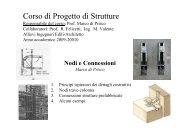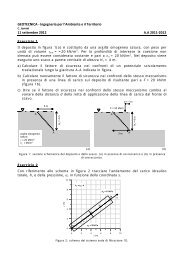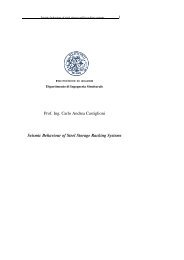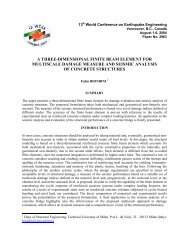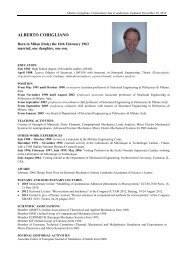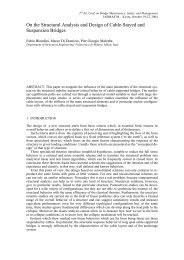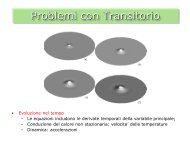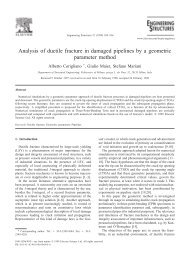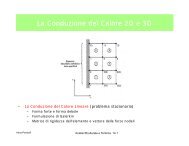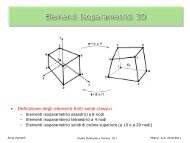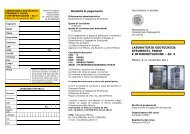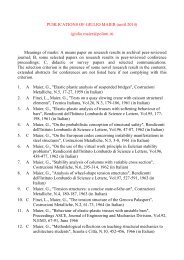Crosta and di Prisco 1067Fig. 11. Numerical 2D <strong>seepage</strong> analysis performed to interpret superficial soil piping: (a) sketch of boundary conditions (h, hydraulichead); (b) evolution of the saturation boundary at successive time steps; and (c) water-content contours at steady condition.water <strong>seepage</strong>. In this case they favoured <strong>seepage</strong> withindeeper, unsaturated, and relatively more permeable layers.(2) The spatial variation of hydrogeologic properties affectedthe flow field and, in particular, the presence of a underlyingwater flow contrast allowed for an increase in thehorizontal component of flow (Fig. 1).(3) The flow convergence at the toe of the <strong>slope</strong> whichwas likely due to a rise in the local water table (Fig. 1) increasedthe hydraulic gradient within the domain and, as aconsequence, influenced the evolution of superficial <strong>seepage</strong><strong>erosion</strong> and tunnel scouring. Flow convergence became progressivelymore important with the uphill spring head retreat,intensifying downhill the rate of headward <strong>erosion</strong> anduphill the <strong>seepage</strong> <strong>erosion</strong> and tunnel scouring.(4) No direct observations regarding the evolution of <strong>seepage</strong><strong>erosion</strong> and tunnel scouring exist, except for somesmall-scale physical models (Higgins et al. 1990), and geomorphicevidence is rarely discernible.Numerical modellingNumerical results of a two-dimensional (2D) analysis ofthe flow concentration phenomenon within a homogeneoussand layer will clarify the subvertical and sub-horizontal <strong>seepage</strong><strong>erosion</strong> and tunnel scouring within the upper sandy layer.<strong>On</strong>ly the hydraulic aspect was considered. The commercial finiteelement numerical code SEEP/W (Geo-Slope InternationalLtd. 1996a; Fredlund and Rahardjo 1993) was used.The 2D <strong>seepage</strong> within partially saturated soils was reproduced<strong>by</strong> assuming the sand within the layer to be uniformand hydraulically isotropic and homogeneous. The hydraulicproperties of the sand are summarized in Figs. 10a and 10b(uniform sand curves). The following assumptions were made© 1999 NRC Canada
1068 Can. J. Geotech. Vol. 36, 1999Fig. 12. Evolution of the saturated domain with time within the <strong>slope</strong> (see Fig. 7 for soil stratigraphy) as obtained <strong>by</strong> numericalmodelling (a) 1 month and (b) 5 months after deep incisions were made.concerning the initial boundary conditions (Fig. 11a): (i) thehydraulic head within the soil domain is initially constantwith the water table coincident with the lower boundary; (ii) ahydraulic head is applied at the upper right-hand corner(source); this hydraulically describes a single superficial incisioncutting through the flooded rice field (see observation 3in the previous section); (iii) a hydraulic head, constant withtime, is imposed on the lower left-hand corner (sink); this describesthe presence of a lower tension crack cutting throughthe low-permeability layer; and (iv) the remaining boundariesare assumed to be no-flow boundaries.In Fig. 11b, a schematic view of the evolution of the saturateddomain with time is represented. The presence of thelow-permeability layer (i.e., the grey silty layer) on the bottomand the tension crack causes saturation of a limitedzone. Moreover, the water flow becomes more localized withtime and the saturation bulb in the upper zone becomes moreand more narrow. This happens when the wetting frontreaches the sink (constant-head point at the lower left-handcorner, i.e., the tension cracks, Fig. 11a). From Fig. 11c, itisevident that the band within which the water contentchanges is very narrow. <strong>On</strong>ly within this narrow domain isthe material saturated (degree of saturation S r = 100%).These numerical results seem to justify, from a hydraulicpoint of view, the onset of <strong>seepage</strong> <strong>erosion</strong> and tunnel scouringwithin a superficial permeable layer above a relativelyimpermeable layer. Naturally, in three dimensions, it is possibleto imagine <strong>seepage</strong> localization within a tunnel of saturatedsoil. More simulations (not reported here for the sakeof brevity) were performed <strong>by</strong> increasing the distance betweenthe water source and the lower drainage point. Theseshowed that the saturated domain becomes more elongated.Seepage <strong>erosion</strong> and the propagation of tunnel scouringbecome possible if (i) the capillary stresses, which are <strong>induced</strong><strong>by</strong> partial saturation, are sufficient to ensure (at leasttemporary) stability of the tunnel opening; and (ii) there issufficient transport capacity (i.e., sufficient flow and minimumhydraulic gradient), which will erode sediments fromthe passage. The first condition may be satisfied if partialsaturation and the arching effect are taken into account. Withrespect to the second condition, an analysis of the problem ismore difficult.Seepage within the <strong>slope</strong>To interpret the onset of this kind of <strong>slope</strong> <strong>instability</strong>, it isimportant to point out that the collapse is the final result of acomplex chain of events taking place during a certain timeperiod. An important role is played <strong>by</strong> the <strong>seepage</strong> evolutionwith time within the entire <strong>slope</strong> domain. The analysis iscomplex because of the partial saturation of materials, the3D geometry of the problem, the heterogeneity of materials,and the presence of tension cracks and localized water flows.The hydraulic conductivity was about 2×10 –3 to3×10 –2 cm/s for the sands versus 3×10 –5 tol×10 –4 cm/sfor the silts (see Fig. 8 and Table 1). As the flow direction isinfluenced <strong>by</strong> the differences in hydraulic conductivitywithin the soil stratigraphy, it can be assumed that the flowcould be horizontally deviated.© 1999 NRC Canada



